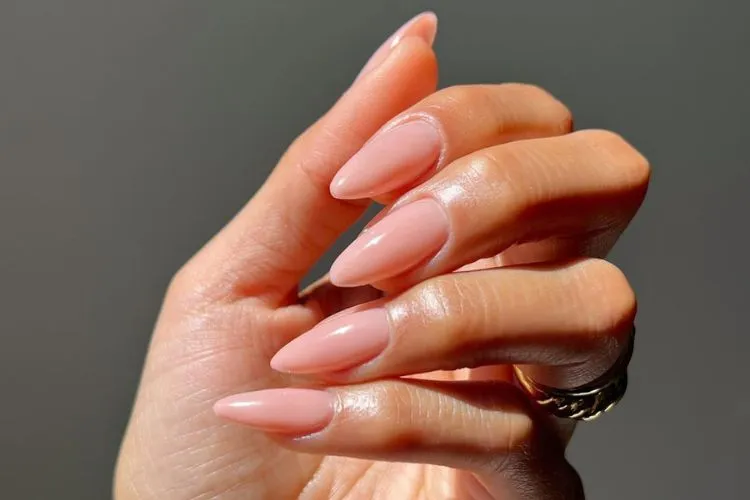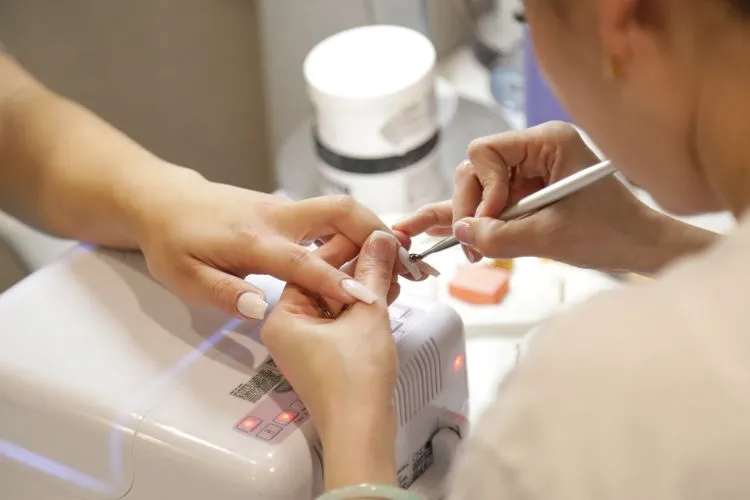Nail enhancements have long been a popular choice for those seeking to beautify and protect their nails. Among the various options available, acrylic overlays stand out as a noteworthy option.
Unlike full set acrylic nails that extend the length, acrylic overlays strengthen and enhance the natural nails without extending them.
This article delves into what is acrylic overlay, how they are applied, their advantages and disadvantages, and what maintenance they require.

What is Acrylic Overlay?
Acrylic overlay involves the application of a mix of acrylic powder and a liquid monomer over the natural nails. It hardens upon exposure to air, providing a durable coat over the natural nails.
This technique caters mostly to those who prefer to maintain their natural nail length while enjoying the strength and versatility of acrylic.
How are Acrylic Overlays Applied?
Preparation
The process begins with thorough cleaning and buffing of the natural nails. This step is crucial to remove any oils and debris, ensuring better adhesion of the acrylic.
A dehydrator is then applied to remove moisture, followed by a primer to help the acrylic mixture adhere better.
Application Process
A technician mixes the acrylic powder with the liquid monomer to form a bead. This mixture is applied to the natural nail and shaped before it hardens.
It is crucial that this step is performed quickly and skillfully to achieve a smooth, even layer.
Finishing Touches
Once the acrylic has hardened, the technician files and buffs the nails to create a smooth, appealing finish. The nails can then be painted with nail polish or left natural.
It’s essential that the finished look is not only aesthetically pleasing but also free of any sharp edges or bumps.
Pros and Cons of Acrylic Overlays

Pros
Acrylic overlays offer durability and strength, making them ideal for individuals with weak, brittle nails. They also provide a protective layer, helping to prevent nail breakage.
Furthermore, acrylic overlays allow for a natural look while still offering the customization available with traditional acrylics like color and shape.
Cons
Despite their benefits, acrylic overlays can be damaging to the natural nails if they are incorrectly applied or removed.
They require regular maintenance, which can be time-consuming and costly. Additionally, individuals with sensitive nails or allergies to acrylic may not find this option suitable.
Maintenance and Aftercare
Maintaining acrylic overlays involves regular fills every two to three weeks to accommodate natural nail growth and prevent lifting.
Proper removal is also critical to avoid damaging the underlying natural nail. At home, it is recommended to apply cuticle oil regularly to nourish the nails and keep the cuticles healthy.
Choosing the Right Technician

The outcome of an acrylic overlay significantly depends on the skill of the nail technician. It is essential to choose a technician with experience and a portfolio of their work.
A good salon will maintain high standards of hygiene and use quality materials, which are critical factors to consider when getting any nail enhancement.
Types of Acrylic Mixtures
Within the realm of acrylic nail enhancements, a variety of acrylic powders and liquid monomers are available, each tailored to specific uses and providing unique benefits.
Acrylic powders come in a spectrum of colors and finishes, from clear and natural shades to vibrant colors and glitter-infused options for those seeking a more decorative look.
There are also different set times and workability characteristics, such as fast-setting powders for experienced technicians.
The liquid monomers that are mixed with these powders can contain different additives to enhance adhesion, reduce odor, or minimize the potential for allergic reactions.
Together, the powder and monomer form a malleable bead that, once sculpted and hardened, creates a durable enhancement suited to a client’s aesthetic preference and lifestyle.
Health and Safety Considerations
Health and safety are paramount in the application of acrylic overlays, both for the client and the technician. To prevent allergic reactions or sensitivities, it is crucial to conduct a patch test before proceeding with a full application, particularly if the client has a history of nail product sensitivities.

Technicians should wear gloves and masks to avoid prolonged exposure to monomer vapors, which can cause respiratory issues or skin irritation. Ensuring a well-ventilated workspace is essential to disperse fumes effectively.
Salon hygiene practices should include sterilizing all tools before use and adhering to strict sanitation protocols to prevent cross-contamination and infections. Clients should also be advised on proper aftercare to maintain nail health and avoid potential complications.
You may also find useful: Hard Gel Nails vs Acrylic Nails | How Long Do Acrylic Nails Last?
Frequently Asked Questions (FAQs)
Can acrylic overlays be applied to short nails?
Yes, they can be effectively applied on short nails, offering strength without the need for extensions.
How long do acrylic overlays last?
Typically, acrylic overlays last between two to three weeks before requiring a fill.
Are acrylic overlays damaging to natural nails?
If applied and removed correctly by a professional, the damage to natural nails can be minimal. However, improper handling can lead to issues such as nail thinning.
How do you remove acrylic overlays safely?
It’s best to have acrylic overlays removed by a professional. They know the proper techniques to minimize damage to the natural nails.
Can you change the color of your nails with acrylic overlays?
Yes, the overlays can be painted over with nail polish, allowing for color changes as desired.
Conclusion:
Acrylic overlays offer a perfect solution for those looking to strengthen their natural nails without opting for extensions.
While they come with their set of pros and cons, the key to a satisfying experience lies in proper application, regular maintenance, and the choice of a skilled nail technician.
By following these guidelines, you can enjoy the benefits of durable, beautifully enhanced natural nails.
In conclusion, educating yourself on the specifics of nail enhancements can lead to better decisions and more satisfying outcomes.
Should you consider getting acrylic overlays, we recommend consulting with a professional to tailor the treatment to your needs and ensure the health of your nails in the long run.

Meet Isabella Anderson, your acrylic painting mentor with over a decade of brush-wielding mastery. Dive into the colorful world of acrylics with her expert guidance, featured exclusively on ‘Acrylic Authority.’ Unleash your inner artist and explore the limitless possibilities of this versatile medium alongside a true acrylic aficionado.
